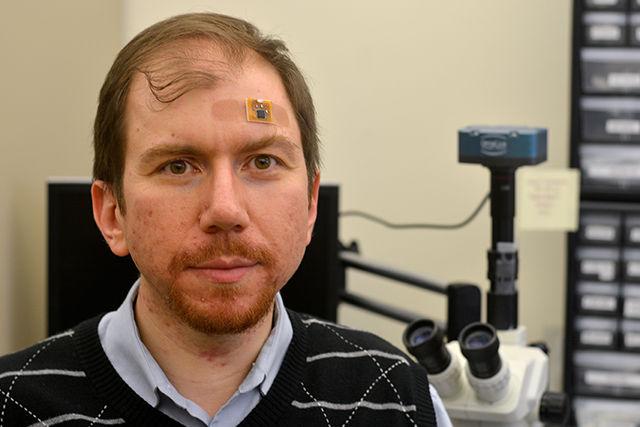
Sugandha Singh
Alper Bozkurt, assistant professor in Electrical & Computer Engineering department, is the inventor of the smart bandage which records the sleep stages of the user and wakes them up at the lightest hour of their sleep.
Sleepiband, a wireless headband with a miniature smart bandage that measures the quality of sleep, along with a mobile app that aims to improve sleep, are being developed by the iBionics lab at NC State.
The iBionicS lab is working in collaboration with the Duke Medical Center’s Sleep Disorders Laboratory to start clinical trials near the end of this semester.
The Sleepiband is placed on the forehead of the user and the multimodal sensor measures brain waves, oxygenation, movement, and electrical impulses in the brain, according to Alper Bozkurt, an assistant professor in electrical and computer engineering.
The bandage works by using a light-emitting diode, or LED, which emits photons at two wavelengths red and near infrared, the photons couple with tissue and are refracted back at different wavelengths depending on the oxygenation of the blood. The wavelengths of the returning photons show the oxygenation level of the blood which indicates the quality of sleep.
The photons are collected by a small photo detector and the wavelengths are measured, said Brinnae Bent, a junior in biomedical engineering.
Bozkurt describes that it is similar to when you put a red laser to your finger and you can see a spot on the other side and on the same side there is a red circle around it.
On the exterior of the smart bandage, there is essentially a tiny computer with a Bluetooth radio along with EEG amplifiers and an accelerometer that measures movement of the head, according to Bozkurt.
The Sleepiband is different from the current clinical products that are much bulkier and counter effectively interfere with patients sleep. When you go to a regular sleep clinic, they connect a number of electrodes around your head and put on finger clips and a chest band.
“They connect multiple things to you and then they try to measure your sleep, and unfortunately you cannot sleep with those and in the morning they say, ‘Oh, you have a sleep problem,’” Bozkurt said.
The Sleepiband is able to identify sleep stages and sleep events, such as sleep apnea, according to Bozkurt. Sleep apnea is a condition where a person cannot breathe while sleeping, affecting brain oxygenation and leading to poor quality sleep.
The Sleepiband is ground breaking. Measuring the oxygenation in the brain is adding a new modality, and this helps to miniaturize everything into the form factors of a flexible bandage, Bozkurt said.
Currently getting a sleep study done is expensive, but bringing all these products into this form not only enables a more reliable way to monitor sleep, but also the low cost allows people to buy this product and monitor their own sleep at home, Bozkurt said.
The app the iBionics lab is developing can recommend behaviors that will improve sleep. If the user is having problems with their sleep, the app can tell set their alarm clock to wake them at an optimal time.
“We are developing this product with our collaborators at Duke,” Bozkurt said. “These professors are studying sleep, and we’re getting advice from them on the app.”
The low cost not only enables a consumer product, but also a medical product that can be used in a clinics, Bozkurt said.
“Sleep is something that’s very important, and we unfortunately sometimes voluntarily sacrifice our sleep,” Bozkurt said. “It affects the intellectual capability, emotions and physical activity during the day and unfortunately we are not aware of its importance.”
The Sleepiband has received the Chancellor’s Innovation Award, which allowed the iBiotics team to produce a prototype from the lab data. The product has also been awarded a grant from the National Institute of Health which will be used to conduct clinical trials.